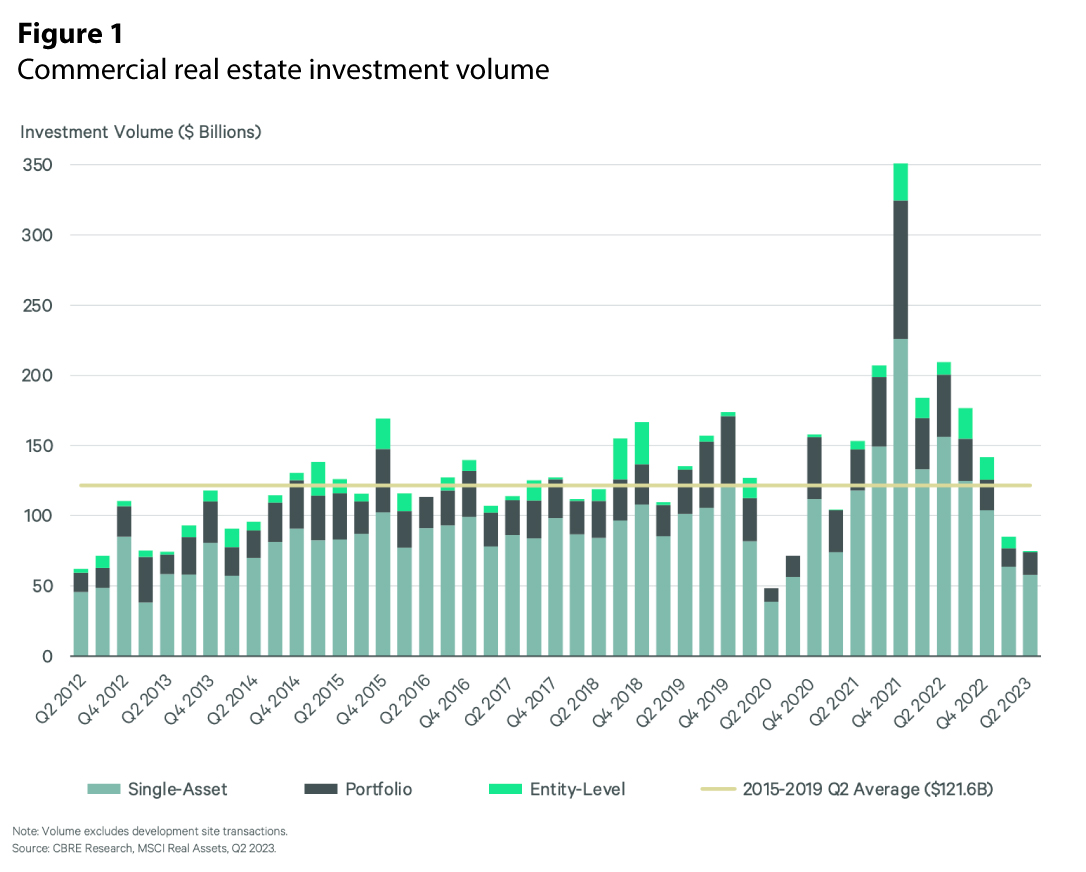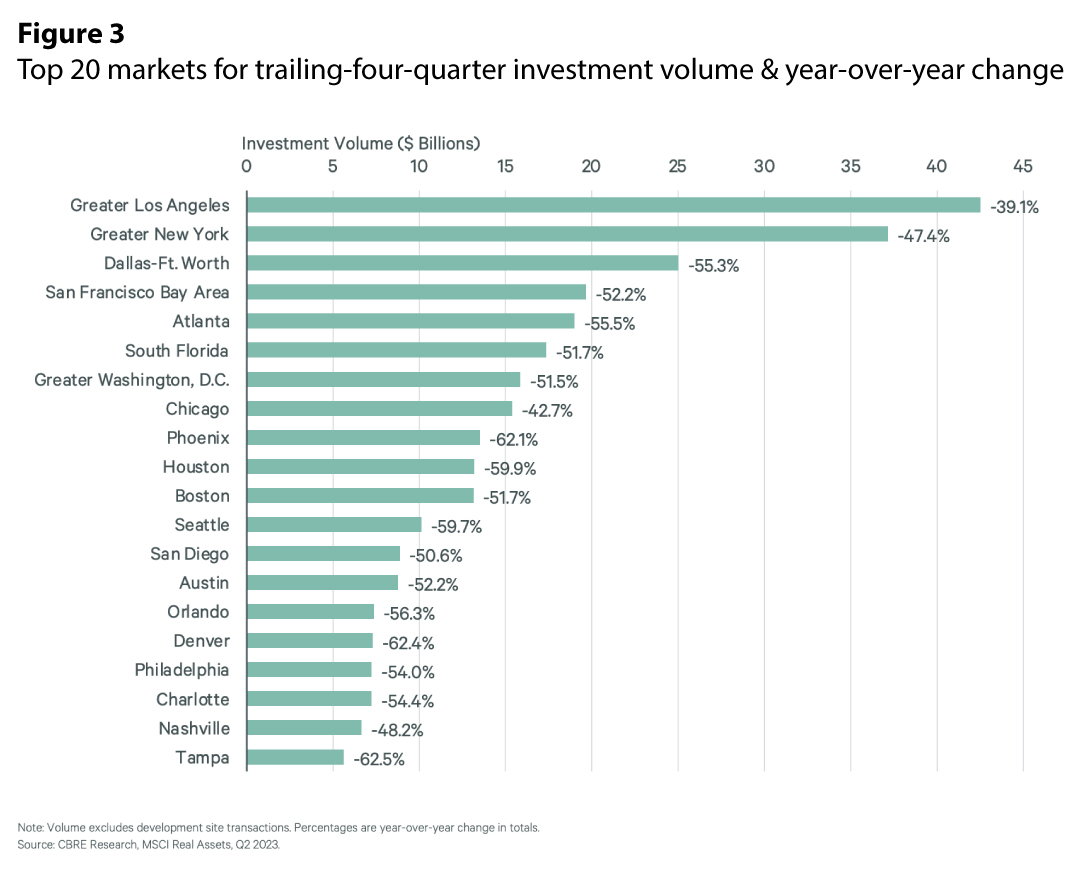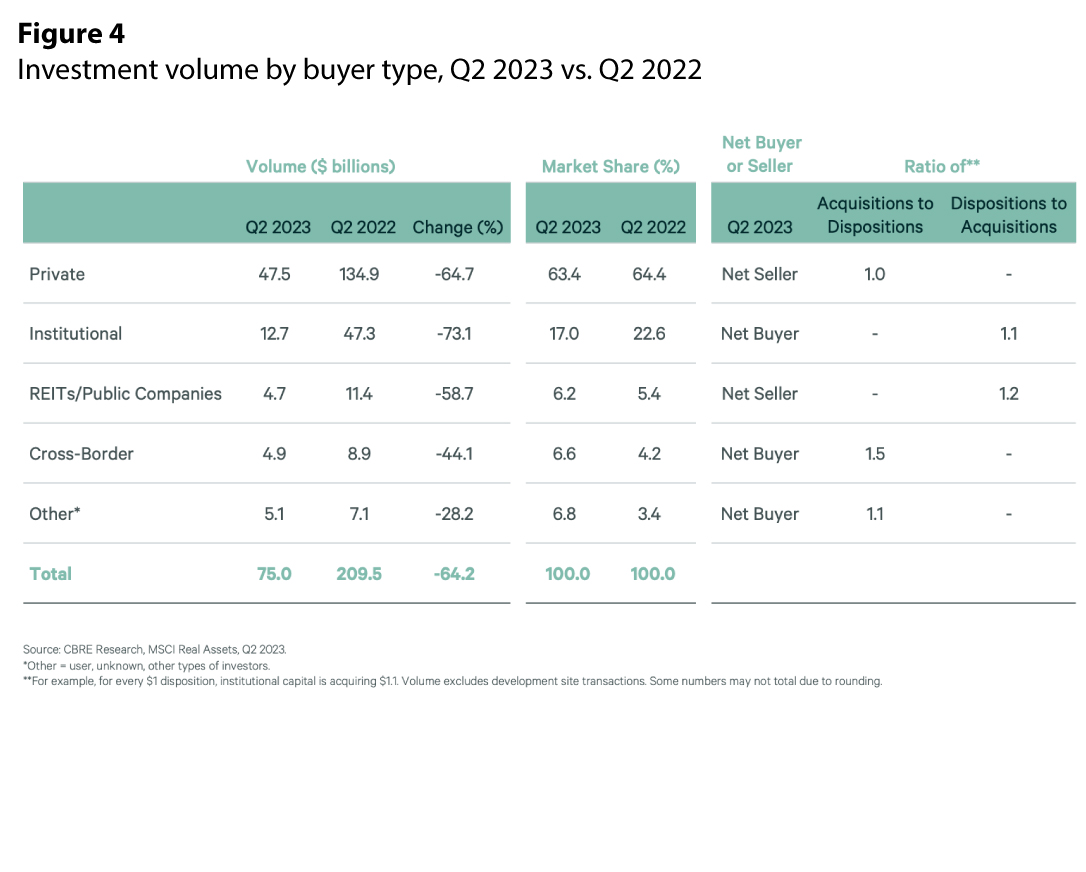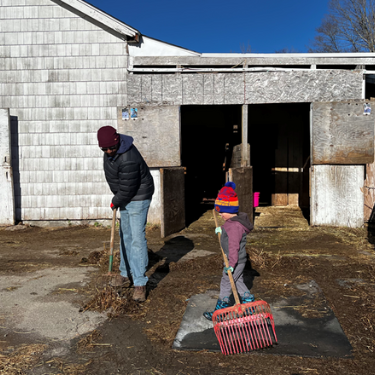IN FOCUS

Insurers, Policyholders Struggle with Market Disruptions as Natural Disaster Costs Surge
Insurance companies and policyholders are grappling with the increasing frequency and severity of natural disasters. According to the Federal Insurance Office, in 2022, there were 18 natural disasters that each cost at least $1 billion. Another recent study says that sea level rise could wipe $108 billion from the U.S. property market by mid-century, reducing property tax revenue and threatening local economies.
Rising Premiums, Tightening Markets
Thanks in part to escalating disaster response costs and increasing encroachment by developers on vulnerable land, insurance policies are becoming more expensive and restrictive, particularly in the commercial real estate market. Insurers are raising premiums, drastically cutting capacity, limiting coverage, and, in some cases, ceasing to offer policies in high-risk markets.
Premiums for commercial property jumped 18.3% in Q2 of 2023. Major insurance companies like State Farm and Allstate have stopped offering new commercial (and homeowner’s) policies in California, citing high construction (lingering supply chain issues) and materials costs, increased catastrophe exposure, more expensive reinsurance, and regulatory challenges, like stricter building codes enacted after natural disasters.
Other markets like New Jersey are experiencing tornadoes and other wind events more frequently, and insurance coverage is becoming more restricted. Under the state’s new inland flood protection rules, New Jersey is now calculating appropriate flood elevations for new development projects based on prospective, not historical, events.
California’s Sweeping Reforms
Recognizing that its insurance market is experiencing significant disruption, California regulators recently announced sweeping reforms. The goal is to shift homeowners and businesses from the state’s insurer (the FAIR plan, which was supposed to be temporary) back to private policies, more accurately price at-risk homes, and address insurers’ concerns to stabilize the market. Under the historic agreement, the state will no longer bar insurance companies from using forward-looking catastrophe models when pricing policies. Previously, California only allowed insurers to use historical, 20-year-old data.
Although there is limited knowledge of the effect of severe weather events on the commercial real estate market, an August Moody’s report suggests a link between escalating CRE insurance premiums and weather-related disasters. It found that the average insurance cost for properties exposed to more significant climate risks tends to be higher. For example, the growth in multifamily property insurance costs tracks closely with the frequency of $1 billion in natural disasters in the U.S.
Developers, CRE Firms Seek Stability
Because most large developers and CRE firms aggregate their insurance risk and spending, the strategy of pooling property in different markets under a comprehensive insurance policy makes sense. Commercial growth in high-risk areas amid escalating natural disasters exacerbates risk and increases premiums for every policyholder. Specialty insurance companies with stable reinsurance support offering coverage for unique or challenging situations could offer more consistent capacity at market rates. Ultimately, availability and coverage options vary geographically since insurance is regulated at the state level.
Impact on Transactions, Risk Management Strategies
The tightening insurance market directly impacts CRE transactions; rising costs and policy availability can affect or impede projects and projected returns. “Many CRE clients are now including the availability of commercial insurance in due diligence,” according to Christopher Alviggi, Head of Environmental Risk Practice, NFP Property & Casualty. “They are becoming increasingly concerned with the cost of risk, attachment points, and punitive terms and conditions.” These conditions beg the question – what happens if insurance becomes commercially unviable?
Given the dynamic nature of the insurance industry, property owners and businesses must continuously assess and adjust their coverage and risk management strategies. This involves proactively reviewing asset aggregation and commensurate insurance policies to address market challenges and ensure sufficient protection. Staying informed about regulatory activities and maintaining clear communication with brokers and insurers is crucial for understanding policy changes and sustaining a comprehensive CRE risk management approach.
CRE MARKET UPDATE
The Latest Market Updates in the U.S. Commercial Real Estate Industry
The U.S. commercial real estate (CRE) investment volume in the second quarter of 2023 was $75 billion, according to CBRE Research. This represents a 64% year-over-year decrease and marks the fourth consecutive quarter of declining investment volume. The trailing four-quarter volume at the end of Q2 2023 was reported at $479 billion, indicating a 50% decrease compared to the previous year. (Fig 1)
Multifamily remained the top sector with $28 billion in transaction volume, followed by Industrial at $21 billion. The Office sector continues to face challenges, characterized by weak demand and high vacancies, where investment volume fell by 62% year over year in Q2 to $11 billion, and a national vacancy rate of 18.9%. Los Angeles remained the top investment market with $43 billion, followed by New York with $37 billion and Dallas/Ft. Worth with $25 billion. (Fig 2 & 3)
Private and foreign investors showed increased buying activity, while REITs and institutions sold more properties than they bought. Foreign investment capital decreased significantly by nearly 50% compared to the same quarter in the previous year. This decline may be attributed to economic uncertainty and the strength of the U.S. dollar. (Fig 4)
To view larger images and dive deeper into the data, click on the images above.
Latest Developments
Harnessing the Power of Emerging Technology

In an October 2023 ERIS Originals article, ERIS discussed how emerging technologies like artificial intelligence and augmented reality are transforming environmental and business practices, becoming a vital tool for policymakers and business leaders. The United Nations recognizes AI’s potential to address climate change, and U.S. EPA Administrator Michael Regan has expressed the agency's desire to “harness the power of artificial intelligence” on environmental justice and climate issues.
AI applications have reshaped the commercial real estate industry, generating more precise home valuations, optimizing energy-efficient smart buildings, and using predictive analytics to forecast commercial real estate trends. Additionally, aerial imagery collected from drones is increasingly used in CRE property assessments, as well as for monitoring environmental remedies and institutional controls. For that reason, ASTM International’s Subcommittee E50.02 on Real Estate Assessment and Management is developing a standard guide to support the use of drones in CRE assessments.
Augmented Reality technology has the potential to enhance environmental awareness and education and play a role in real estate and energy management. It offers immersive experiences that enhance understanding of climate data and provides real-time insights into energy consumption, helping organizations make informed decisions to reduce waste and improve sustainability.
Because AI raises significant privacy and data accuracy concerns, transparent, unbiased, and accountable decision-making processes are essential to integrating emerging tech into business strategies and environmental practices. Read the full article here.
Exploring Redevelopment Opportunities in the Energy Transition

A recent ERIS webinar offered a comprehensive look at the intersection of the transition to renewable energy and real estate redevelopment. Participants had the chance to explore a wide spectrum of policy and financial incentives, such as tax credits and power purchase agreements, which are pivotal in driving the adoption of renewable energy and ensuring the economic viability of these redevelopment projects. The event, held September 26th, featured a stellar panel of industry and legal experts, including Dan French, Founder & Principal of dbForesites; Annika Colston, Founder & CEO of AC Power; and Betsy Mason, Associate General Counsel at Catalyze.
Brownfields, former landfills, and underutilized sites were explored as prime candidates for repurposing into solar farms and potentially for other sustainable ventures. The discussion provided valuable insights into the complex legal considerations that shape siting decisions, including regulatory frameworks, as well as zoning, title, and land access issues. Environmental due diligence was emphasized as a crucial step in identifying and mitigating potential risks associated with developing sites for solar and other renewable energy uses.
The panelists highlighted community-scale solar's role in brownfields redevelopment, emphasizing how it brings clean energy to local communities through smaller solar installations. A New Jersey case study presented by solar developer A.C. Power showcased a specific example of how community-scale solar has been integrated into a Superfund site redevelopment. This case study provided insights into practical implementation strategies and related challenges of solar redevelopment on environmentally impaired properties serving as a real-world reference for similar projects elsewhere.
You can watch a full recording of the webinar here.
PFAS Now Included in NECIs, CERCLA Designation Pushed to 2024
In August, the U.S. Environmental Protection Agency announced its National Enforcement and Compliance Initiatives (NECIs) for 2024-2027, naming PFAS one of its top priorities. The key goals are to conduct site assessments, control ongoing releases that threaten human health and the environment, and ensure compliance with permits addressing PFAS contamination.
In the announcement, the agency said it intends to hold responsible “major manufacturers and users of manufactured PFAS” but not to pursue farmers, water utilities, airports, or local fire departments if EPA designates perfluorooctanoic acid (PFOA) and perfluorooctanesulfonic acid (PFOS) as hazardous substances under the Comprehensive Environmental Response, Compensation, and Liability Act (CERCLA).
The rule to designate PFOA and PFOS as CERCLA hazardous substances was proposed last September but has not been finalized. EPA extended its deadline from August 2023 to February 2024. More than 60,000 public comments were submitted, with many requesting specific liability exemptions for “passive receivers” and other parties who have not manufactured or used PFAS. The delay could give Congress time to address this opposition. Sen. Cynthia Lummis, R-Wyo., introduced several bills in early May that would protect various industries from liability.
Also pending is EPA’s advance notice of proposed rulemaking to consider seven other PFAS as hazardous under CERCLA: perfluorobutanesulfonic acid (PFBS), perfluorohexane sulfonic acid (PFHxS), perfluorononanoic acid (PFNA), hexafluoropropylene oxide dimer acid (HFPO-DA, sometimes called GenX), perfluorobutanoic acid (PFBA), perfluorohexanoic acid (PFHxA), and perfluorodecanoic acid (PFDA).
State Developments
Alabama's Proposed Tank Trust Fund Revisions: Lower Costs, Expand Coverage, and Streamline Applications
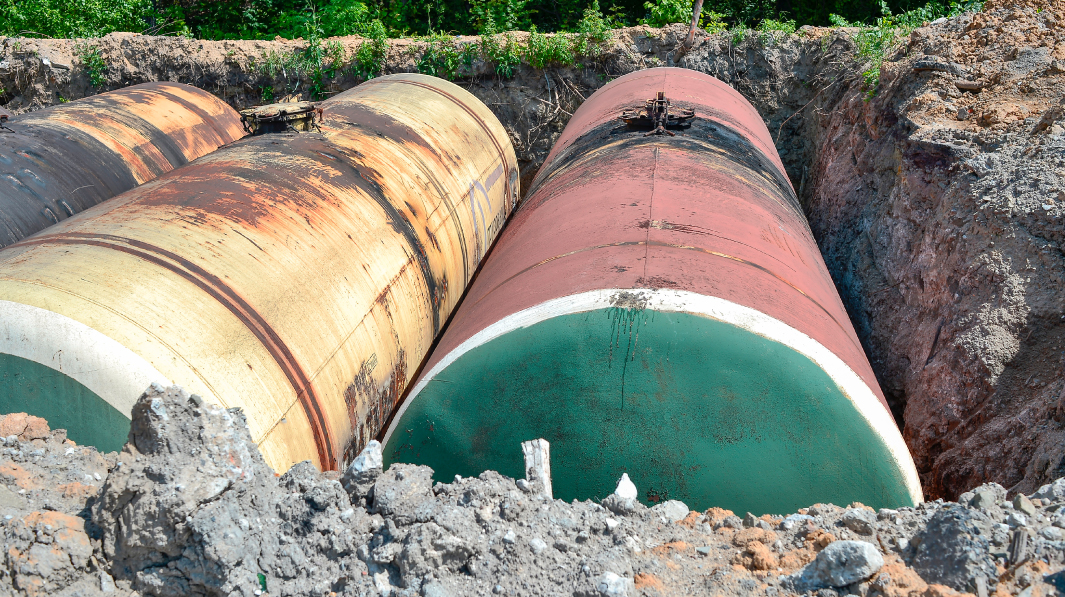
Alabama’s Department of Environmental Management is proposing changes to its Tank Trust Fund to make it cheaper, deeper, and less stringent for applicants. The proposed revisions would reduce the premium owner/operators pay for coverage by 17% (from $.012/gallon to $.01), expand the per-incident indemnification from $1.75M to $2M, and lower the liability burden for contractors. The latter would happen by rescinding a provision in the agency’s reimbursement application rule (335-6-16-.14), thereby eliminating the requirement for applicants to include a signed statement that the spill was unintentional. The change allows third parties, such as site remediators, to apply directly for reimbursement. Applicants must still attest to the validity and correctness of the information in the application itself. The comment deadline was October 17, 2023.
Oklahoma's Updated Regulations Simplify Oil & Gas Conservation and Clarify Brownfields Program Rules
The Oil & Gas Conservation Division of Oklahoma Corporation Commission is adopting comprehensive changes to well operations and related remediation. The amendments add a standard for closed pit systems, including disposal requirements, requirements regarding well-site and surface facilities, and general horizontal well requirements. New clarifications on underground injection wells address casing cement requirements and give better direction on administration, including transfer (and termination) of authority, monitoring, reporting, and the capacity to evaluate simultaneous injection well authority. The adopted regulations also clarify the brownfields program rules, including providing consistency with federal grant terms, responsible party liability, requirements for submitting applications, and electronic submission options. The new rules update forms and eliminate others, including monthly reports of unallocated natural gas production.
Strengthening Hazardous Material Response in North Carolina: Proposed Regulations for Regional Response Team Program

The North Carolina Department of Public Safety, Division of Emergency Management (NCEM) has issued a proposal to formalize the regulations for the state Regional Response Team (RRT) program. While the RRT program has been operational since 1993, the regulations are intended to provide clarity and consistency for participating response teams and responsible parties. The RRT program includes seven regional response teams that are intended to enhance local response capabilities, for example when a hazardous materials incident requires more sophisticated equipment or hazardous materials technicians who have received a higher level of training. In particular, the proposed rules include requirements for program eligibility, certification and training, and reimbursement procedures for NCEM to recoup costs from responsible parties. The proposal outlines the process for NCEM to bill responsible parties for personnel and equipment costs, with payment due within 30 days of receipt.
Content provided by STP ComplianceEHS.

ASTM Committee Week
The ASTM Committee E50 on Environmental Assessment, Risk Management, and Corrective Action will meet from October 30 to November 2, at the Washington Hilton in Washington, DC. The meeting will be a valuable opportunity to collaborate and exchange ideas with like-minded professionals. There will be several technical training sessions taking place onsite. The E50 Social will be on Wednesday, November 1, from 5:30 – 6:30 pm. Additional details, including the schedule, technical trainings, and registration, are available here.
New Environmental Liabilities Certification Program
ASTM International will release a new Environmental Liabilities certification program in December. The certification program is designed for professionals providing estimation, valuation, auditing, and attestation to one or more portfolios of environmental liabilities. The certification program will test the knowledge of how to identify, value, characterize, and explain environmental liabilities. The program will require individuals to complete a training course and successfully pass an exam to become a Certified Environmental Liabilities Professional. The cost of the prerequisite Environmental Liabilities course is $899 and the exam is $450.
ASTM will be holding an in-person session at October Committee Week in Washington, DC.
CRE Investors Brace for Potential Foreclosures
 With interest rates continuing to rise and little relief on the horizon for CRE investors, many have speculated that foreclosures are sure to follow. While the data supports that hypothesis, we’ve yet to see a significant increase from our lender clients.
With interest rates continuing to rise and little relief on the horizon for CRE investors, many have speculated that foreclosures are sure to follow. While the data supports that hypothesis, we’ve yet to see a significant increase from our lender clients.
A recent report from TREPP indicated that $5.65B in CRE loans have been modified this year, with 20% of those being extensions of 37 months or more. Trading in a 4% interest rate for one closer to 7% isn’t ideal for borrowers. Combined with downward pressure on commercial prices and the overall market sentiment, it's easy to see why owners are hesitant to refinance. However, these factors all contribute to borrowers having an increasingly difficult time keeping up with mortgage payments.
In the CMBS world, the rate of delinquent or special servicing loans has increased to 6.8%. That’s up from 4.5% in June of last year. To put that number into perspective, the peak delinquency rate of 10.2% occurred in 2012 after the Great Recession.
As one might guess, Office vacancy has contributed dramatically to the negative state of affairs with the national vacancy rate hovering around 17% as companies continue to struggle with return to office strategies. Even Class A space is not immune as property owners are being forced to either repurpose, make upgrades, or look for alternative financing options.
Major metros like Chicago, Denver, Philadelphia, and San Francisco have been hit the hardest so far. Fifteen of the top 20 US markets saw a rise in the rate of distressed commercial mortgage backed securities according to KBRA.
Looking at Denver specifically, we’ve seen two high-profile buildings slip into foreclosure. Both were purchased in 2019 pre-pandemic. The first of those buildings is The 410 at 410 17th St., which was purchased for $127 million, and the second is a neighboring office building at 1801 Broadway that sold for $40 million. In both cases the ownership group could not meet the terms of the loan.
These two deals come on the heels of last year's foreclosure of the Denver Energy Center, which was sold at auction following a 45% decrease in value.
The fire sale on CRE assets has not happened yet and probably won’t for at least a year. Time will tell as there is close to $1.5 trillion in CRE loans coming due in the next two years.
Featured ERIS Data Set
Enhancing Storage Tank Data Collection for ASTM 1527-21 Compliance
Storage tank data is a vital component of environmental due diligence records searches. ERIS continually improves its data collection process to ensure the most comprehensive and accurate information is available to support ASTM 1527-21 compliance.
Multiple sources and formats exist for obtaining data related to storage tanks. Government agencies increasingly provide mapping tools, online search resources, master files, and data dumps accessible through download, email request, or FOIA.
Our data research and collection team navigates this diverse landscape with vigilance, routinely monitoring agency websites and open data portals for tank data updates. When we identify multiple data sources, our analysts rigorously assess the information, focusing on discrepancies. Typically, these discrepancies involve facility records appearing in one dataset but not in another and vice versa. Our team recognizes that it's not enough to choose one data file over another – our customers need records from all available sources. To that end, our system seamlessly integrates storage tank data from multiple files. This integration process ensures customers receive a comprehensive and accurate dataset, facilitating compliance with ASTM 1527-21.
ERIS is committed to providing reliable and all-encompassing data solutions for your environmental due diligence work. Stay tuned for more updates on our ongoing data collection and integration improvements. For more information about our data collections, please connect with us at [email protected], or live chat with us at erisinfo.com.
Thank you for trusting us with your data needs!
Spotlight On
Special Profile: Noel Roman, Project Manager, Scriva
Noel Roman is a highly experienced Project Manager who specializes in environmental due diligence consulting and sales. With over a decade of expertise in the environmental data field, Noel is skilled at both business development and customer care. Noel's top priority is understanding the unique needs of his clients and delivering unparalleled support through ERIS.
Noel has been an integral part of the ERIS team for three years. For the past year, he has held the position of Project Manager, facilitating clients’ adoption of ERIS’ innovative report-authoring platform, Scriva.
Noel's multicultural upbringing has shaped his unique perspective on life. With roots in both Connecticut and Puerto Rico, he brings a diverse range of experiences to his work, allowing him to approach challenges from multiple angles and achieve outstanding results.
When he isn’t hard at work, Noel enjoys a rich and fulfilling personal life with his loving family, including his wife, young son, and a dog named Bailey. To relax, Noel enjoys cycling and indulging in classic cheese pizza. He also dedicates some of his time to volunteering at a horse and farm animal rescue/sanctuary, reflecting his deep commitment to helping animals in need. Additionally, Noel serves as a coach for high school and Amateur Athletic Union (AAU) youth basketball teams, where he shares his passion and knowledge for the sport with young athletes.
To learn more about Noel Roman, including his full bio, click here.
Upcoming Events

October 25, Virtual – ERIS Webinars presents Dry-Cleaning Sites Part III: It’s Time to Remediate! In this third and final edition in our series, Michael Marcon, VP and Principal at InControl Technologies, and Larry Schnapf, Principal at Schnapf LLC, will examine the challenges in selecting remediation strategies, explore some of the technologies commonly employed for remediation, review common data and design considerations for developing an appropriate and effective response action plan, and discuss the legal issues and potential liabilities connected to remediating dry-cleaning sites. Join ERIS for an informative 60-minute review of this important area of site remediation. Register here.
October 30-November 2, Washington, DC – Join ERIS’ Scott Davis at ASTM Committee Week.
November 1-3, Orlando, FL – Join ERIS’ Jeanie Bunt at the Florida Remediation Conference.
November 7, Phoenix, AZ – Join ERIS’ Frank Dickerson at EPIC's 3rd Annual RemFest.
November 9, Dallas, TX – Join ERIS’ Amanda Sugg at the EnviroWorkshop.
December 5-6, Portland, OR – Join ERIS’ Maggie Losoya at the Business & The Environment Conference.
December 12-14, Orlando, FL – Join ERIS’ Jeanie Bunt at ASTM Phase I & Phase II Environmental Site Assessment Processes Training.


